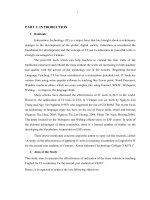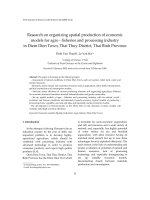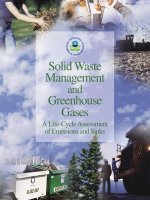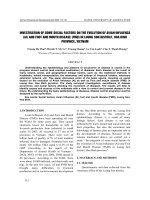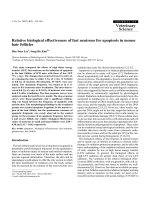Effectiveness of domestic solid waste management in luong son town luong son district hoa binh province
Bạn đang xem bản rút gọn của tài liệu. Xem và tải ngay bản đầy đủ của tài liệu tại đây (880.5 KB, 54 trang )
MINISTRY OF AGRICULTURE AND RURAL DEVELOPMENT
VIETNAM NATIONAL UNIVERSITY OF FORESTRY
STUDENT THESIS
EFFECTIVENESS OF DOMESTIC SOLID WASTE MANAGEMENT IN
LUONG SON TOWN, LUONG SON DISTRICT, HOA BINH PROVINCE
Major: Natural Resources Management
Code: D850101
Faculty: Forest Resources and Environmental Management
Student
: Nguyen Thi Hieu
Student ID : 1453061153
Class
: K59A Natural Resources Management
Course
: 2014 – 2018
Advanced Education Program
Developed in collaboration with Colorado State University, USA
Supervisor: MSc. Nguyen Thi Bich Hao
Ha Noi, 2018
ACKNOWLEDGEMENT
First and foremost, I would like to express my great appreciation to MSc. Nguyen Thi
Bich Hao from Vietnam Forestry University, my research supervisor, for her enthusiastic
encouragement throughout my research project. Her ideas, knowledge and efforts are heavily
embedded in this study.
I wish to extend my thanks to the lecturers of the university, who have taught me for
more than four years, and to the cooperation of Vietnam Forestry University and Colorado State
University, especially, the faculty of Forest Resource and Environment Management.
Finally, I would like to express my deep appreciation to the staffs in Hoang Long
Investment Limited Company and local people live in Luong Son town, Luong Son district,
Hoa Binh province for the enthusiastic help during the work. Due to the limited knowledge,
time, and experience, this thesis still needs to be improved. I am looking forward to receiving
feedback from teachers and friends to enhance it.
Xuan Mai, 9th September 201
Student
Nguyen Thi Hieu
i
CONTENTS
ACKNOWLEDGEMENT.............................................................................................................. i
CONTENTS .................................................................................................................................. ii
LIST OF TABLES ........................................................................................................................ v
LIST OF FIGURES ...................................................................................................................... vi
ABSTRACT .................................................................................................................................. 1
CHAPTER I. INTRODUCTION .................................................................................................. 2
1.1. Overview of solid waste ......................................................................................................... 2
1.1.1. Definition............................................................................................................................. 2
1.1.2. The origin of domestic solid waste...................................................................................... 2
1.1.3. Classification domestic solid waste ..................................................................................... 3
1.1.4. The composition of domestic solid waste ........................................................................... 4
1.2. Impact of domestic solid waste .............................................................................................. 5
1.2.1. Impact on the environment .................................................................................................. 5
1.2.2. Impact on public health ....................................................................................................... 5
1.2.3. Impact on the urban landscape ............................................................................................ 5
1.3. The current state of domestic solid waste management ......................................................... 6
1.3.1. In the world ......................................................................................................................... 6
1.3.2. In Viet Nam ......................................................................................................................... 6
1.4. Some methods of treatment domestic solid waste.................................................................. 7
CHAPTER II. RESEARCH GOAL AND OBJECTIVES ............................................................ 9
2.1. Goal ........................................................................................................................................ 9
2.2. Specific objectives .................................................................................................................. 9
CHAPTER III. RESEARCH METHODS................................................................................... 10
3.1. Study site .............................................................................................................................. 10
3.1.1. Geographical location........................................................................................................ 10
ii
3.1.2. Topography ....................................................................................................................... 11
3.1.3. Climate .............................................................................................................................. 11
3.1.4. Resources........................................................................................................................... 12
3.1.5. Population .......................................................................................................................... 12
3.1.6. Economy ............................................................................................................................ 13
3.2. Study methods ...................................................................................................................... 13
3.2.1. Investigating and doing research on the field .................................................................... 13
3.2.2. Interview method ............................................................................................................... 15
3.2.3. Method of determining the composition of domestic solid waste..................................... 16
3.2.4. Statistical methods and data analysis ................................................................................ 17
CHAPTER IV. RESULTS AND DISCUSSIONS ...................................................................... 18
4.1. Current situation of domestic solid waste at Luong Son town, Luong Son district, Hoa Binh
province ....................................................................................................................................... 18
4.1.1. Sources of domestic solid waste in Luong Son town ........................................................ 18
4.1.2. The amount of domestic solid waste generated every day in the town ............................. 21
4.1.3. The forecast volume of domestic solid waste in Luong Son town to 2020....................... 24
4.2. The impacts of domestic solid waste on the environment and public health in Luong Son
town, Luong Son district, Hoa Binh province ............................................................................. 26
4.2.1. Impacts of domestic solid waste on the environment........................................................ 26
4.3. Current situation of management and treatment about domestic solid waste at Luong Son
town ............................................................................................................................................. 31
4.3.1. The situation of domestic solid waste management .......................................................... 31
4.3.2. Classification, collection and transportation of domestic solid waste at Luong Son town. .... 32
4.4. Proposing solutions to improve the effectiveness of domestic solid waste management in
Luong Son town .......................................................................................................................... 37
4.4.1. Environmental protection policy ....................................................................................... 38
iii
4.4.2. Collection of domestic solid waste .................................................................................... 38
4.4.3. Improvement transportation of domestic solid waste efficiency....................................... 38
4.4.4. Other support methods ...................................................................................................... 39
CONCLUSIONS, EXISTENCES, AND RECOMMENDATIONS ........................................... 40
1. Conclusions ............................................................................................................................. 40
2. Existences ................................................................................................................................ 40
3. Recommendations ................................................................................................................... 41
REFERENCES
APPENDIX
iv
LIST OF TABLES
Table 1.1. Definition of the domestic solid waste composition. ................................................... 4
Table 1.2. Advantages and disadvantages of some methods of domestic solid waste treatment .. 7
Table 3.1. The weight of domestic solid waste generated by households in one day ................. 14
Table 4.1. The composition of domestic solid waste calculated according to the results of an
actual analysis in Luong Son town .............................................................................................. 19
Table 4.2.The component of domestic solid waste in Luong Son town ..................................... 20
Table 4.3. The amount of domestic solid waste generated every day in the town ...................... 21
Table 4.4. Population forecast of Luong Son town ..................................................................... 24
Table 4.5. The forecast volume of domestic solid waste in Luong Son town to 2020 ............... 25
Table 4.6. The rate of gas components generated from landfill .................................................. 29
Table 4.7. Results of interview sanitation workers in Luong Son town ..................................... 34
Table 4.8. Results of household interviews on domestic solid waste management .................... 36
v
LIST OF FIGURES
Figure 1.1. Some methods of domestic solid waste treatment ...................................................... 7
Figure 3.1. Map of Luong Son town, Luong Son district, Hoa Binh province ........................... 10
Figure 4.1. Sources of domestic solid waste in Luong Son town ............................................... 18
Figure 4.2. Proportions of different categories of domestic solid waste in Luong Son town .... 20
Figure 4.3. The volume of domestic solid waste generated in Luong Son town ........................ 25
from 2017 to 2020 ....................................................................................................................... 25
Figure 4.4. Wastewater generated at the landfill in Luong Son town ......................................... 27
Figure 4.5. The gases are generated during the waste treatment process .................................... 28
Figure 4.6. Impact of domestic solid waste on public human health .......................................... 30
Figure 4.7. The system of domestic solid waste management at Luong Son town ..................... 31
Figure 4.8. The model collection and transportation of DSW at Luong Son town ..................... 32
Figure 4.9. Waste is being collected by workers on their cart and then transferred into a truck.......... 33
Figure 4.10. Landfill at Luong Son town, Luong Son district, Hoa Binh province .................... 33
Figure 4.11. Waste disposal site at Luong Son town, Luong Son district, Hoa Binh province .. 33
vi
ABSTRACT
Management of domestic solid waste is a major challenge in urban regions of the most
part of the world, including Southeast Asia. In the past decade, strong economic growth and
uncontrolled urbanization have greatly magnified the problems with Vietnam’s domestic solid
waste management system. Not only has been an increase in the amounts of waste generated,
but the composition of the waste has also changed as well.
Given the rapid rates of urbanization occurring around the world, the importance of an
efficient and effective domestic solid waste management system is more critical than ever
before. In recent years, Luong Son town has a high economic growth rate with the increase in
population, the volume of domestic solid waste rose significantly. However, behind the
economic benefits of investment projects, the assessment of the effectiveness of solid waste
management is becoming a difficult problem to solve in environmental management and
protection.
Therefore, I selected this study to provide a practical basis for assessment of domestic
solid waste management in Luong Son town, Luong Son district, Hoa Binh province. From that,
proposing solutions to improve the effectiveness of domestic solid waste management in the
study area.
1
CHAPTER I. INTRODUCTION
1.1. Overview of solid waste
1.1.1. Definition
The Resource Conservation and Recovery Act (RCRA), passed in 1976, created the
framework for America’s hazardous and non-hazardous waste management programs. The
Resource Conservation and Recovery Act (RCRA) states that "solid waste" means any garbage
or refuse, sludge from a wastewater treatment plant, resulting from industrial, commercial,
mining, agricultural, and from community activities [6].
Domestic solid waste, commonly known as trash or garbage (US), refuse, or rubbish
(UK) is a waste type consisting of everyday items that are discarded by the public. The organic
waste potions consist of food and kitchen waste... Inorganic waste consists of paper, plastic,
glass, wood, and metal products such as drink cans [12].
1.1.2. The origin of domestic solid waste
The original of domestic solid waste includes:
- Residential area: it generated from household such as paper, cardboard, yard
clippings, wood, plastic, rubber... and also some hazardous waste.
- Commercial activities: it generated from restaurant, market, hotel or office... Waste
sources have the same composition as for residential areas (food, paper, glass...)
- The office: it generated from school, administrative agency. Waste sources have the
same composition as for residential areas and commercial activities but less volume.
- Agricultural activities: it generated from straw, pesticides, manure, and other waste
from the farm, harvest waste or fertilizer...
- Construction activities: it generated from brick, stone, gravel...
- Industrial activities: it generated from heavy metals like lead, mercury, ore...
2
- Hospital and clinic: it generated from activities involving health protection such as
drugs and pharmaceuticals, cleaning and disinfection products, bandages, other plastics, ...
1.1.3. Classification domestic solid waste
Classification domestic solid waste can be based on many different criteria such as
classification by location, by chemical and physical composition, and by the level of hazard.
a. Classification by location of formation
According to the location of formation: Depending on the location, waste can be divided
into municipal solid waste, household waste [4].
- Household waste also known as domestic waste or residential waste is refuse
generated by households.
- Municipal solid waste is more commonly known as garbage - consists of everyday
items we use and then throw away, such as product packaging, furniture, bottles, food scraps,
newspapers, appliances,... This comes from homes, schools, hospitals, and businesses [13]...
b. Classification by chemical and physical composition
According to chemical and physical composition: According to the chemical nature,
wastes can be divided into organic waste, and inorganic waste [4].
- Inorganic waste means waste is composed of all those waste resulting from products
and materials that we use in our daily activities. It can be sand, salt, iron, calcium...
- Organic waste is an organic material. It can also include paper, cardboard, timber,
food, and lawn clippings, etc.
c. Classification by level of hazard
- Household hazardous solid waste includes waste is flammable, corrosive, containing
radioactive substances or heavy metals [13].
3
- Household non-hazardous solid waste means waste does not contain hazardous, often
waste generated in family activities [13].
1.1.4. The composition of domestic solid waste
Domestic solid waste consists of many different components. Information on domestic
solid waste composition plays an important role in evaluating, selecting methods and treatment
equipment. Table 1.1 defines the definition of domestic solid waste.
Table 1.1. Definition of the domestic solid waste composition.
Component
Definition
Examples
a. Paper
Materials made from paper and pulp.
Paper bags, toilet paper...
b. Textiles
Originated from the fibres.
Fabrics, wool, nylon...
c. Food
Food waste from household...
Fruit shells, corn-cob...
d. Grass, wood
Products made from wood, bamboo ...
Wooden furniture: tables, chairs...
e. Plastic
Products made from plastic...
Plastic bottles, electric wire...
f. Leather, rubber
Products made from leather and rubber.
Ball. shoe, wallet...
1. Inflammable substances
2. Non-flammable substances
Component
Definition
Examples
Materials and products made from iron
a. Ferrous Metals
that are easily absorbed by the magnet.
Tray, metal roofing...
Any kind of material non-combustible
b. Glass
and made from glass.
Bottle, light bulb...
This material can be divided into 2
c. Stone and
porcelain
types: one size is over 5mm and another
Pebbles, sand...
size is smaller than 5mm.
(Source: Nguyễn Xuân Nguyên, Trần Quang Huy, 2004))
4
1.2. Impact of domestic solid waste
1.2.1. Impact on the environment
a. Soil
Domestic solid waste generated from a residential area, school or commercial area when
released into the environment, it changes the composition and characteristics of the soil such as
pH, ... For non-biodegradable waste, if we don’t have any treatment measures, it will reduce the
fertility of the soil, affecting the development of animals and plants live in soils.
b. Air
While solid waste is disposed of in the processes of combustion or landfill, it would
generate harmful NOx gases, dioxin,... from combustion and CH4, NH3, H2S... from the landfill.
These gases are not treated, so will bad affect the ambient air.
c. Water:
Domestic solid waste can clog plumbing, rivers,... which interfere with the flow of
water. The water flows through the ponds and lakes that contaminate the surface water.
1.2.2. Impact on public health
There are potential risks to environment and health from improper handling of solid
wastes. Direct health risks concern mainly the workers in this field, who need to be protected.
There are also specific risks in handling wastes from hospitals and clinics.
1.2.3. Impact on the urban landscape
Domestic solid waste that is not collected or transported to the prescribed places will
cause environmental issue and effect to the urban landscape.
5
1.3. The current state of domestic solid waste management
1.3.1. In the world
Around the world, waste generation rates are rising. In 2012, the worlds’ cities
generated 1.3 billion tons of solid waste per year, amounting to a footprint of 1.2 kilograms
per/person/day. With rapid population growth and urbanization, municipal waste generation is
expected to rise to 2.2 billion tons by 2025.
A significant amount of municipal solid waste is burned and converted to energy.
Overall about 33.1 million tons, or 13%, of municipal solid waste was combusted for energy
recovery in 2014, this is down slightly from 34 million tons in 2000. And the rise of recycling,
composting, and burning municipal solid waste to produce energy provides significant
environmental and economic benefits.
1.3.2. In Viet Nam
Recently, Vietnam has faced great challenges in domestic solid waste management
including not only the collection, transfer, and final disposal of waste but also a lack of public
awareness of the domestic solid waste system. The amount of domestic solid waste generated in
Vietnam has been increasing steadily over the last decade.
According to the 2011 report of the Department of Natural Resources and Environment
(DONRE), the amount of municipal solid waste generated in urban areas only increased
roughly 10-16% every year from 2007 to 2010. The total volume of urban solid waste generated
in 2007 was 17.682 tons/day and increased to 26.224 tons/day in 2010. And it can be observed
that the amount of solid waste generated per capita per day also increased from approximately
0.75 kg/person/day to almost 1.0 kg/person/day.
In Luong Son town, Luong Son district, Hoa Binh province, many people live near the
waste treatment area in sub-area 10 urgent with the situation of environmental pollution.
6
According to Nguyen Hong Bao, secretary of sub-area 10, people live far from more than one
kilometre but still suffocate by the air of bad smell.
For this reason, I selected the study to provide a practical basis for assessment of
domestic solid waste management at Luong Son town, Luong Son district, Hoa Binh province.
Therefore, proposing solutions to improve the effectiveness of domestic solid waste
management in the study area.
1.4. Some methods of treatment domestic solid waste
Methods of treatment domestic solid waste
Composting
Recovery
and
Recycling
Landfill
Incineration
Figure 1.1. Some methods of domestic solid waste treatment
Table 1.2. Advantages and disadvantages of some methods of domestic solid waste
treatment
Some methods of treatment
Advantages
Disadvantages
domestic solid waste
1. Composting
-
Composting
reduces
the - If done incorrectly,
- It is an easy and natural amount of waste in landfills.
biodegradation process that - It can be done in-house
takes organic wastes i.e. - It creates fertile soils.
remains of plants and garden
and kitchen waste and turns
into nutrient-rich food for
your plants.
7
composting can attract pests.
- Solid waste burned at very - It requires a high amount of
2. Incineration
- Incineration is a type high temperatures can be used initial capital.
disposal method in which to produce electricity.
municipal solid wastes are - It will make
burned at high temperatures returned to soils.
- The cost of treatment
nutrients emissions is large.
When
incineration
so as-as to convert them into - Incineration makes up much
domestic solid waste, it will
residue
and
gaseous less space than landfills.
cause air pollution
products.
- Ash still needs to be
disposed of.
- It may have every category of - It is initially cheap, but
3. Landfills
solid
waste, costs increasing rapidly as
- The landfills are the most domestic
including hazardous materials. place fill up, therefore,
popularly used method of
waste disposal used today. - Methane from decomposition expensive to develop the
This
process
of
waste may be captured for energy new place.
disposal focuses attention on production.
- People must be lined to
burying the waste in the land.
prevent leachate infiltrating
ground or surface water
sources.
- It brings the risk of health
problems.
- Waste in the landfill can
cause the greenhouse effect.
4. Recovery and
Recycling
- Glass can be melted and re- - Recovery and recycling are
shaped into new bottles or jars not always cost effective.
- The process of taking items indefinitely; this requires less - It requires high initial
for a specific next use. These energy than making new capital.
discarded items are then bottles and jars.
processed
to
extract
recover
materials
or - Metals (aluminium is the durable.
and most common and cost-
resources or convert them to effective
energy in the form of useable recycling;
heat, electricity or fuel.
- Products may not be as
material
steel
frequently recycled).
8
is
for
also
CHAPTER II. RESEARCH GOAL AND OBJECTIVES
2.1. Goal
The research results contribute to improve the effectiveness of local environmental
management and quality of the living environment in the study area.
2.2. Specific objectives
- Assessing the current situation of domestic solid waste in Luong Son town, Luong Son
district, Hoa Binh province.
- Investigating impacts on surrounding environment caused by domestic solid waste in
Luong Son town, Luong Son district, Hoa Binh province.
- Assessing current performance of domestic solid waste management in the study area.
- Proposing solutions to improve the effectiveness of domestic solid waste management
in the study area.
9
CHAPTER III. RESEARCH METHODS
3.1. Study site
Study site includes Luong Son town, Luong Son district, Hoa Binh province. Figure 3.1
shows the location of the study site.
Figure 3.1. Map of Luong Son town, Luong Son district, Hoa Binh province
3.1.1. Geographical location
Luong Son town is a gateway in the East of Hoa Binh province, adjacent to the capital
of Hanoi and the Northwest of the country. It closes to Hoa Lac Hi-Tech Park, Phu Cat urban
area and the cultural village of the Vietnamese ethnic groups. The town is located in
geographical coordinates: from 105o25'14"E to 105o41'25"E and from 20o36'30"N to
20o57'22"N.
- Kim Boi and Lac Thuy district in the South.
10
- Ky Son district in the West.
- Quoc Oai (Ha Noi city) in the North.
- My Duc and Chuong My district in the East.
The total area of the district is 36,488.85 hectares, divided into 20 administrative units,
including 19 communes and 1 town (Cao Dam, Cu Yen, Hoa Son, Hop Hoa, Lam Son, Lien
Son, Nhuan Trach, Tan Vinh, Thanh Lap, Tien Son, Truong Son, Trung Son, Tan Thanh, Cao
Duong, Hop Chau, Cao Thang, Long Son, Thanh Luong, Hop Thanh and Luong Son town).
In Luong Son town have rich resources and abundant labour resources. Luong Son has
advantages in geographical location, is the focal point of economic exchanges, cultural - social
between Northwest mountains and the Red River delta.
3.1.2. Topography
About topography, Luong Son town is in the midland, where is the transition between
the delta and mountainous, so the terrain is very diverse. The low mountainous terrains are at
the height of about 200 - 400m above the sea level and formed by magma, limestone, and
terrigenous sediments, with a dense network of rivers and streams.
Currently, Luong Son town has a total natural land area of 1,725.61 ha, including
agricultural land and forestry land, accounting for 35.47%. The soil is mainly red feralite on
sedimentary rock, suitable for planting perennial crops, fruit trees, and rice.
3.1.3. Climate
Luong Son town climate is a tropical monsoon, with cold winters, less rainfall, hot
summer, and heavy rain.
- The average temperature of the year is 22.9oC - 23.3oC.
- The average rainfall is from 1,520mm to 2,256 mm/year, but unevenly distributed in
the year and even in the season is very erratic.
11
- Luong Son town has a network of rivers and streams distributed evenly in the
communes.
It can be seen that the climate, hydrography, and rivers have created favourable
conditions for Luong Son to develop agriculture, diversify crops and animals, intensify crops
and develop forestry. River systems, dams are not only a source of water for living and people's
life but also for regulating climate, improving the ecological environment and developing
aquatic resources.
3.1.4. Resources
- Water resources: The groundwater in Luong Son has a large reserve. The water
quality is largely unpolluted and is distributed throughout the district.
- Forest resources: The total forest land area is 18,733.19 ha, accounting for 49.68% of
the natural area. The natural forest of the district is diverse and rich with many kinds of
precious wood. But due to human impacts, the forests have lost so much and replaced them
with secondary forests.
- Mineral resources: There are large reserves of limestone, construction stone, clay,
basalt, and multi-metal ores in the district.
3.1.5. Population
The total population of the town is 13.160 people (in 2009). There are 5 ethnic groups in
the town, which Muong people make up about 35% of the population, Kinh people make up
64.5% and other ethnic groups account for 5%. The labour force is abundant, the number of
non-agricultural workers is increasing, the percentage of trained labourers accounts for 55%,
which shows that the district has strength in labour resources.
12
3.1.6. Economy
In 2016, despite the difficulties and challenges, under the leadership of the Party
Committee, the supervision of the People's Council, the direction and management of the
district People's Committee and efforts of all levels, the branches, people of all classes, business
community, the socio-economic of Luong Son district continue to be maintained and
developed.
3.2. Study methods
3.2.1. Investigating and doing research on the field
The thesis conducted investigation and survey in Luong Son town, Luong Son district,
Hoa Binh province to:
- Directly surveying the research area.
- Surveying sources of volume and composition of domestic solid waste at Luong Son
town, Luong Son district, Hoa Binh province.
- Investigating the collection, classification, transportation, and storage of solid waste in
the study area.
- Selecting households to ensure the objectivity and relativity of the results.
- Taking and doing the measurement samples of domestic solid waste to determine the
average volume of domestic solid waste in each household. Conducting samples weight in 50
households in Luong Son town within 7 days.
+ Preparation 10kg weight scale, gloves, masks, waste bags.
+ Starting from 15th of July, 2018 to 21st of July, 2018. Every day takes to measure the
weight of domestic solid waste in the afternoon. The time from 4 pm to 7 pm.
+ Recording the volume of domestic solid waste that can be weighed by each
household, then take the average result.
13
The formula for calculating the average amount of domestic solid waste in each
household:
M1 = (m1 + m2 + m3 + m4 + m5 + m6 + m7)/7
Which: M1 is the average amount of domestic solid waste per household in 7 days (kg/day)
m1, m2, ... m7 is the amount of domestic solid waste per household in one day (kg/day)
The formula for calculating the average amount of domestic solid waste in Luong Son
town:
Maverage = (M1 + M2 + M3 + ... + M50) / 50
Which: Maverage is the average amount of domestic solid waste in Luong Son town (kg/day)
M1, M2, M3, ... M50 is the average amount of domestic solid waste per household in 7
days (kg/day).
+ The results of the survey on the amount of domestic solid waste generated by
households in one day are presented in the following table:
Table 3.1. The weight of domestic solid waste generated by households in one day
The weight of domestic
The number of
Ordinal number
Household
people
1
2
...
49
50
Average
14
solid waste
(kg/household/day)
3.2.2. Interview method
a. Questionnaire
The questionnaire is a research instrument consisting of a series of questions for
gathering information from respondents. Questionnaires can be thought of as a kind of written
interview. In the thesis, using a questionnaire to collect data from a fraction of the population
under investigation and the responses were used to provide assessment of the effectiveness of
domestic solid waste management at Luong Son town, Luong Son district, Hoa Binh province.
In other words, the questionnaire method is found very useful in understanding the field
situation and collecting basic quantitative and qualitative information.
From the results of investigating the study area, the thesis interviewed local people who
live in the sub-zone 10, where is near Hoang Long Investment Limited Company. Thesis used
interview method to investigate information about the impacts of domestic solid waste on the
surrounding environment and public health.
In fact, preparing 2 questionnaires, each questionnaire form includes 15 questions.
- For household: conducted interviews with 50 households at Luong Son town, Luong
Son district, Hoa Binh province, especially people live near in sub-zone 10.
- For garbage collector: Interview the garbage collectors at Luong Son town, Luong Son
district, Hoa Binh province.
The questionnaire related to the current state of physical and socio-economic status,
demography, and educational background, information about the pollution situation in Luong
Son town.
15
b. Survey technique
Direct contact (face-to-face) surveys were conducted in the research. This method
allows researchers to ask more questions, longer questions, more detailed questions, more
opened-ended questions and more complicated or technical questions.
Interviewee: households and individuals...
3.2.3. Method of determining the composition of domestic solid waste
Steps to determine the composition of domestic solid waste in Luong Son town.
- Throwing domestic solid waste that has been collected on the floor.
- Mixing carefully the domestic solid waste.
- Domestic solid waste piled in a cone.
- Dividing the cone into 4 equal parts and take two cross sections: (A + C) or (B + D)
after that mixing them.
- Dividing each cross section (A + C) or (B + D) into two equal parts.
- Taking cross sections into two parts, then from each part taking out half a piece
(approximate 20 ÷ 30 kg) for physical classification.
- Classification domestic solid waste into the following components:
16
+ Biodegradable solid waste: food scraps, rice, vegetables, leave, shell fruit...
+ Non-biodegradable solid waste: plastic, brick, paper, glass, cloth, sandy soil...
- Using the weight to determine the volume of each type and proportion.
3.2.4. Statistical methods and data analysis
To conduct this study, the survey uses the method of data processing by Excel software.
In addition, using some calculation methods such as:
a. The amount of domestic solid waste generated is calculated according to the formula.
M=IxN
M: Volume of waste (kg/day)
N: Population of the year (person)
I: Average waste generated (kg /person/day)
b. The formula for calculating the amount of domestic solid waste generated in a year.
M=
(tons)
M: Volume of waste in a year (tons/year)
N: Population of the year (person)
R: Waste generated (kg/person/day)
17
CHAPTER IV. RESULTS AND DISCUSSIONS
4.1. Current situation of domestic solid waste at Luong Son town, Luong Son district, Hoa
Binh province
4.1.1. Sources of domestic solid waste in Luong Son town
Recently, the socio-economic development associated with the formation of new rural
areas and standard living of people has been improved, therefore, the volume of domestic solid
waste is increasing rapidly in Luong Son town.
The sources of domestic solid waste are shown in figure 4.1.
Households
Markets
Services
Domestic solid
waste
Industrial parks.
Hospitals and clinics
Offices and schools
Figure 4.1. Sources of domestic solid waste in Luong Son town
(Sources: Nguyen Thi Hieu, 2018)
The survey shows that domestic solid waste in Luong Son town, Luong Son district,
Hoa Binh province is generated mainly from households, services, markets, industrial parks,
offices and schools, hospitals and clinics.
- The domestic solid waste from households, markets, services, offices and schools
include mostly left-over or spoiled food, falling, leaves, spoiled fruits...
- The domestic solid waste from industrial parks includes metal or rubber, paper,
leather, glass, ceramics ...
18


